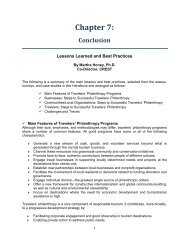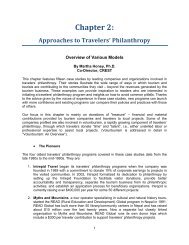Travelers' Philanthropy Handbook - Center for Responsible Travel
Travelers' Philanthropy Handbook - Center for Responsible Travel
Travelers' Philanthropy Handbook - Center for Responsible Travel
Create successful ePaper yourself
Turn your PDF publications into a flip-book with our unique Google optimized e-Paper software.
<strong>Travel</strong>ers’ philanthropy involves a partnership between community and its local projects and atourism business and its travelers. Each of these partners ‘gives and gets’ from successfulphilanthropy. In creating a travelers’ philanthropy program, tourism businesses need to:1. Learn About and With the CommunityTo create effective travelers’ philanthropy programs, tourism businesses need to begin bylearning about – and from – the community that the philanthropy is intended to benefit. Whatare its beliefs, values and practices? Its local aesthetic? The vernacular <strong>for</strong> architecture?What do people see as their main needs, and what are their hopes <strong>for</strong> the future? Who are theleaders, the local change agents, and local institutions and organizations? What benefits doesthe community hope will come through tourism and the financial support of the visitors? Theseare some of the questions that should be answered as a first step towards creating a travelers’philanthropy program.2. Close and Continual Observation and EngagementA tourism business owner or philanthropymanager should walk the community often,interview people in<strong>for</strong>mally, look at local practices,and in other ways do the necessary homeworkand follow up.3. Respond to The Symptoms and TheCausesIn selecting which projects to support, focus bothclose to the tourism site as well as onsystemic problems that may be regional ornational.As we learned on a trip to the Tanzanian village ofOlolosokwan near a safari camp, the local doctormay tell you he needs lots of antibiotics. However,Sea turtle monitoring, Loreto, Mexico. Credit: KamaDeanthis may hide real underlying and more complex needs <strong>for</strong> public education about sociallytransmitted diseases (STDs) and social hygiene or <strong>for</strong> clean drinking water and reliable energysources <strong>for</strong> cooking.4. Diversify StrategiesThere are no silver bullets <strong>for</strong> making positive change so look <strong>for</strong> a variety of opportunities <strong>for</strong>incremental improvements. Educating children, <strong>for</strong> example, involves adequate nutrition as wellas books or other supplies, classrooms, and good teachers. Unless travelers’ philanthropy fundsare very limited, it is wise to address more than one need of the community and not put all youreggs in one basket.5. Do Your Due DiligenceJust as you’ve carefully designed your business, it’s important to design your philanthropyprogram. You have done your homework to prioritize what needs to be done, diversified yourstrategies, asked <strong>for</strong> and received money from the visitors. Now, you need to do some duediligence on the many possible recipients of funds that help to address your charitable interest.The Ocean Foundation helps its donors by using a 22-point due diligence check. If you don’t,you may not be giving to the organizations and projects that are most effectively addressing aproblem. For example, the most prominent international NGO may not be the best vehicle <strong>for</strong>converting your gift of time, treasure, or talent to something meaningful in the target community.21















